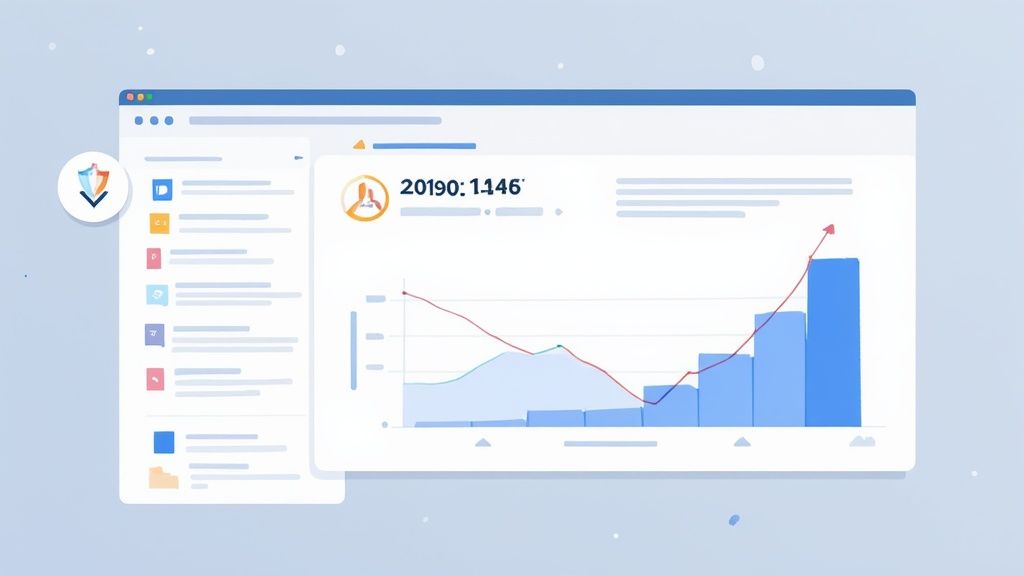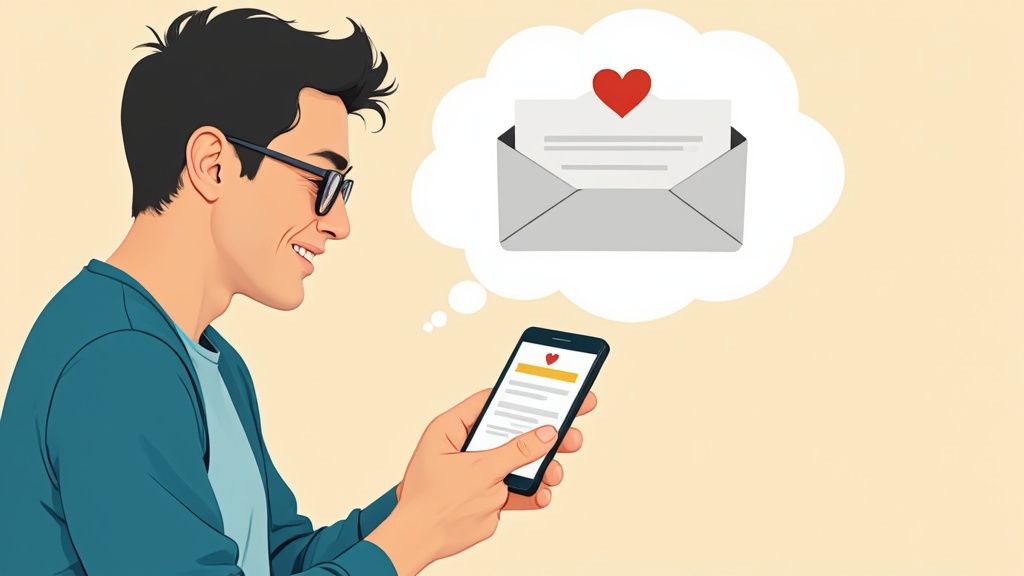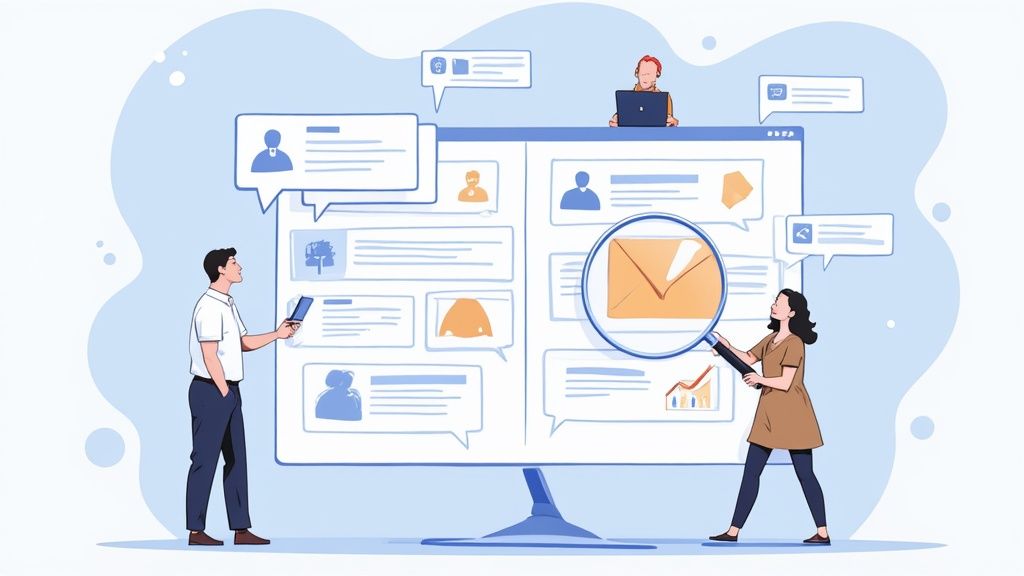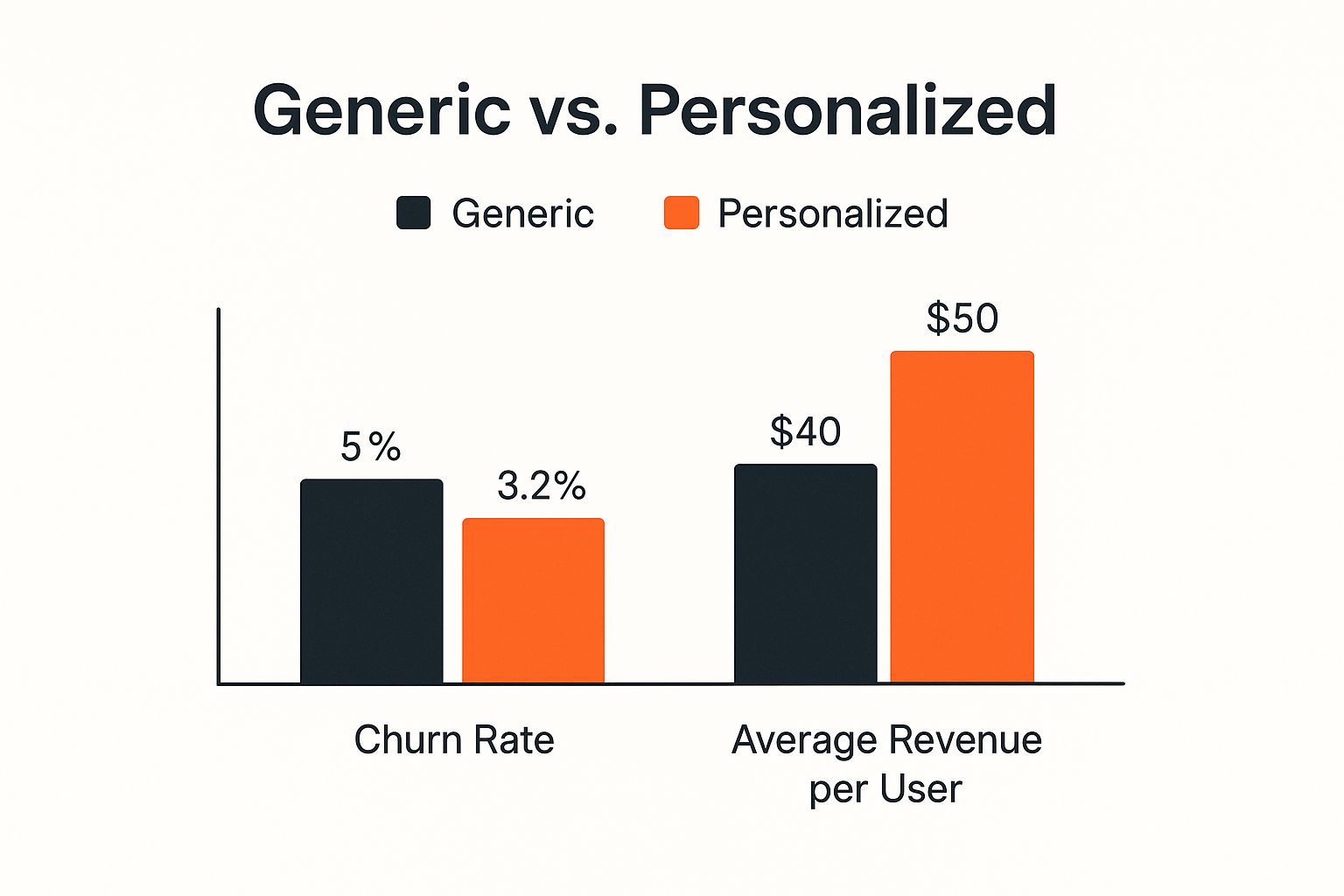Top Strategies to Reduce Subscription Churn & Retain Customers
If you want to reduce subscription churn, your entire mindset has to shift. Stop chasing new users so hard and start focusing on keeping the ones you've already won over. This means digging into why customers are actually leaving and then getting ahead of the problem with smart, proactive strategies. Think slick onboarding, loyalty programs that people actually want, and using your data to step in before it's too late. The real goal is to consistently prove your value and make your service something they can't imagine living without.
Why Reducing Churn Is Your Best Growth Strategy

Before we get into the nitty-gritty tactics, let’s get one thing straight. Churn isn't just another metric on your dashboard. It’s a direct measure of how much value your customers feel they're getting, and it's one of the biggest roadblocks to real, sustainable growth. When churn is high, you’re stuck on a "leaky bucket" treadmill—you have to spend more and more on acquisition just to keep your numbers from dropping.
The true cost of losing a subscriber is so much more than just that one lost payment. It creates ripples that affect your whole business, from team morale right up to investor confidence.
The Hidden Costs of High Churn
When churn is out of control, the damage runs deep. You're not just losing a monthly fee; you're losing a long-term asset. This is especially painful in the subscription economy, where we all know it’s far more profitable to keep an existing customer than to find a new one.
And the numbers back this up in a big way. The global subscription market is on track to blow past $1.5 trillion by 2025. Companies in this space are growing nearly five times faster than the S&P 500. But here’s the kicker: an incredible 70% of subscription revenue comes from existing customers. If you want to dive deeper into these figures, you can explore more about subscription growth trends.
A high churn rate is a flashing red light. It signals a fundamental disconnect between what you promised and what the customer actually experienced. Fixing it isn't just damage control; it's about making your core business stronger.
From Failure Signal to Growth Lever
Instead of seeing churn as a failure, it’s time to reframe it. Think of it as a critical business signal—a source of truth. Every single cancellation is packed with valuable data. It tells you exactly where your product misses the mark, where your onboarding process is a confusing mess, or where your pricing just doesn't line up with the value people see.
This is the mindset that separates the businesses that thrive from those that just tread water. It takes a real, company-wide commitment to:
- Listen to Feedback: Proactively find out why people are leaving. Use exit surveys, of course, but don't be afraid to pick up the phone.
- Analyze Behavior: Get into your analytics. You need to spot the users who are at risk of leaving before they even think about clicking that cancel button.
- Keep Adding Value: Never stop improving. Your service needs to get stickier and more essential over time.
When you adopt this perspective, you turn a painful metric into your most powerful tool for improvement. You start building a more resilient business that doesn't just grow, but grows stronger on a foundation of truly loyal customers.
Key Churn Reduction Strategies and Their Impact
To help you visualize how these tactics fit together, this table breaks down the core strategies we'll be covering. Each one tackles a different aspect of the customer journey, but they all share the same goal: making your service indispensable.
| Strategy | Primary Goal | Key Business Impact |
|---|---|---|
| Loyalty Tiers | Reward long-term commitment and increase stickiness. | Increases Customer Lifetime Value (CLV) and brand advocacy. |
| Gamification | Boost daily engagement and make using the service fun. | Reduces passive churn and builds positive user habits. |
| Referral Incentives | Encourage word-of-mouth marketing from happy users. | Lowers Customer Acquisition Cost (CAC) and builds trust. |
| Onboarding Flows | Guide new users to their "aha!" moment quickly. | Improves initial adoption and reduces early-stage churn. |
| Churn Analytics | Identify at-risk users and understand cancellation reasons. | Enables proactive interventions and data-informed decisions. |
By strategically implementing a mix of these approaches, you create a powerful, multi-layered defense against churn that not only retains customers but turns them into your biggest fans.
Crafting an Onboarding Experience That Sticks
https://www.youtube.com/embed/tnQVgzqAhQo
The first few days a customer spends with your product are a make-or-break moment. I’ve seen it time and time again: a confusing or unguided initial experience is a fast track to cancellation. To really get a handle on churn, you have to move beyond a generic "Welcome!" email and design an onboarding flow that proves your product's value, and fast.
This initial period is your best shot at creating that "Aha!" moment—the instant a user truly gets the benefit of your service. When a new subscriber has that experience early, it powerfully reinforces their decision to sign up and builds a real foundation for sticking around.
Guide Users to Their First Win
The main goal during onboarding is to steer new users toward a key action that delivers a tangible win. Don't just show them a bunch of features; guide them to an actual outcome. If you offer a loyalty platform like Toki, the first win isn't just logging in. It's successfully creating their first simple reward, like a 10% discount for new members.
Think about how the best in the business do it. Slack doesn’t just drop you into an empty workspace. It actively pushes you to send your first message and invite a teammate. Dropbox nudges you to upload your first file. These actions aren't random; they're chosen because the data shows they directly lead to long-term retention.
The best onboarding doesn't feel like a tutorial. It feels like a guided success story where the customer is the hero. The goal is to make them feel smart and capable within minutes of signing up.
To get this right, your onboarding needs to be a multi-channel effort that supports the user from different angles.
- Welcome Email Sequence: Don't just send one email. Create a sequence. The first should be a warm, personal welcome. The second should highlight one key action. The third can offer a link to a helpful video or guide.
- In-App Guides: Use tooltips and modals to point users toward the next logical step. These should feel contextual and pop up based on what the user is doing, not as part of a static, overwhelming tour.
- Personalized Check-ins: For higher-value customers, a quick email from a real person can make all the difference. It shows you’re invested in their success right from the start.
From Initial Curiosity to Genuine Loyalty
A solid onboarding process is the first, most important step in reducing subscription churn. It's what turns a user's initial curiosity into a genuine belief that your product is worth paying for. The trick is to map out the critical actions a user must take to be successful and then build your entire onboarding experience around getting them there.
Think about the user's journey. What is the absolute minimum they need to do to see a return on their investment? For an e-commerce merchant using Toki, this might be:
- Set up a points-per-dollar-spent rule. This is the bedrock of any rewards program.
- Create one redeemable reward. This makes the program tangible for their customers.
- Publish the loyalty widget on their site. This crucial step makes the program visible and accessible.
By focusing your in-app guides, emails, and checklists on these three specific outcomes, you cut through the noise and guide the user straight to value. This focused approach ensures they don't get lost or overwhelmed, making them far more likely to stick around and explore everything else you have to offer.
Stopping Involuntary Churn Before It Happens

There's nothing more frustrating than losing a perfectly happy customer because their credit card expired. It’s not a reflection of your service or their satisfaction; it’s a simple, mechanical failure. This is involuntary churn, and it’s a silent killer for subscription revenue.
This kind of churn happens for mundane reasons—an expired card, a soft decline for insufficient funds, or outdated billing details. While it has zero to do with how a customer feels about your product, it can punch a serious hole in your bottom line if you're not actively preventing it. The good news? It's almost entirely preventable with the right systems in place.
Automate Your Defense Against Failed Payments
Your first move should be setting up an automated card updater service. Frankly, this is non-negotiable for any modern subscription business. These services connect directly with major card networks like Visa and Mastercard to automatically refresh expired or replaced card details behind the scenes. Your customer often won't even realize there was a potential issue.
This one tool stops a huge percentage of payment failures from ever occurring, protecting your revenue and saving your customers from a completely unnecessary headache.
Next up is smart dunning. This isn't just about retrying a failed payment over and over. It’s about intelligently retrying based on why the payment failed in the first place.
- Soft Declines: For temporary issues like "insufficient funds," a smart system will wait a few days before trying the charge again.
- Hard Declines: For permanent issues like an "invalid card number," it knows not to bother, which saves you from racking up pointless transaction fees.
Make Billing Updates Frictionless
When automation can't solve the problem, you need to make it dead simple for the customer to fix it themselves. A clunky, confusing process for updating a credit card is a massive, self-inflicted churn risk.
The moment a customer needs to update their billing info should be the easiest, most frictionless experience they have with your brand. Send them a direct, secure link to a simple form—don't make them hunt for it in their account settings.
This is where pre-dunning notices are a lifesaver. These are just gentle, proactive reminders you send before a card is set to expire. The key is the tone—it should be helpful, not demanding.
A good pre-dunning email might sound something like this: "Heads up! Your card on file is expiring soon. To ensure uninterrupted access to [Your Service], you can update your details here in just a few seconds."
This friendly nudge helps you get ahead of the problem while keeping the customer relationship positive. For a deeper dive into these kinds of tactics, our guide on how to reduce customer churn offers even more strategies.
Tackling involuntary churn is just smart business. Billing errors are responsible for over 23% of all subscription cancellations, meaning a huge chunk of your churned customers never actually wanted to leave. By putting automated tools and user-friendly recovery flows in place, you’re plugging a major leak and protecting valuable revenue, just as many top companies have done according to recent subscription industry statistics.
Building Loyalty With Rewards and Engagement

Okay, so you've nailed the onboarding process. Now comes the real challenge: keeping that initial excitement alive. Long-term engagement isn’t just about sending a few emails; it's about making your customers feel like they're part of something bigger.
The goal is to shift their mindset from being a passive user to an active member of your community. When you make engagement truly rewarding, you build a powerful defense against subscription churn. It’s not always about throwing discounts around, either. It’s about creating a system where loyalty feels seen, valued, and reciprocated with benefits that actually matter.
Launch a Loyalty Program That Rewards Stickiness
One of the most reliable ways to build these lasting relationships is with a straightforward, well-thought-out loyalty program. The entire point is to reward the behaviors you want to see more of—things like consistent monthly payments, repeat purchases, and genuine interaction with your platform.
The secret sauce? Offering perks that your customers actually want. A small discount is fine, but the real magic happens when the rewards deepen their connection to your product.
Here are a few ideas to get you started:
- Early Access: Treat your loyal subscribers like true insiders by letting them be the first to try new features. This not only makes them feel special but also gives you a goldmine of early feedback.
- Exclusive Content: Create member-only webinars, in-depth tutorials, or articles that help them master your service.
- Tiered Benefits: Build a ladder of loyalty. A brand-new subscriber might start with a simple points system, while a customer celebrating their one-year anniversary could unlock premium support or even a dedicated success manager.
A great loyalty program isn't about giving stuff away for free. It’s a strategic system that constantly reinforces the value of sticking with your brand. It should make customers feel smart for choosing you every single month.
If you're looking for inspiration on how top-tier companies structure their programs, check out these fantastic customer loyalty program examples. You'll see what might click with your audience. And with tools like Toki, you can easily build out tiered memberships that automatically reward customers as they hit key milestones.
Turn Engagement Into a Game
Gamification is another fantastic tool for creating a sense of progress and encouraging customers to dive deeper into your product. By adding a few game-like elements, you can make routine interactions feel more fun and, frankly, a little addictive.
Think about integrating simple mechanics that give users a little nudge:
- Progress Trackers: Show customers how far they've come. A simple progress bar illustrating their proximity to the next reward tier is a surprisingly strong motivator.
- Badges and Achievements: Award digital badges for completing specific tasks, like trying out a key feature for the first time or successfully referring a friend.
- Challenges and Quests: Set up small, guided tasks that nudge users to explore different corners of your platform. For an e-commerce tool, a quest might be: "Create your first discount code and earn 50 bonus points."
These small touches tap into our innate desire for achievement and recognition. They transform otherwise mundane actions into rewarding little wins, building positive habits that weave your product into a customer's daily routine. That kind of consistent, positive interaction makes them far less likely to churn and can even turn them into your biggest fans.
Using Data to Predict and Prevent Churn
By the time a cancellation notice hits your inbox, it's often too late. The real secret to slashing subscription churn isn't about winning back lost customers; it's about making sure they never want to leave in the first place. This means getting ahead of the problem by using your own data to spot the subtle warning signs.
Think of your customer data as a goldmine. Every login, click, and interaction tells a story. When you learn to read those stories, you can identify at-risk users long before they hit the "cancel" button and step in with the right kind of help.
Spotting the Red Flags: What At-Risk Behavior Really Looks Like
Knowing what to look for is half the battle. While every business has its own unique patterns, some red flags are almost universal. These aren't just abstract metrics; they're clear signals that a customer is slowly drifting away.
Start by keeping a close eye on these tell-tale signs:
- A Drop-off in Activity: This is the big one. If a user who used to log in every day now only shows up once a week, their engagement is fading. It's often the first and most reliable indicator of trouble.
- Shifting Feature Use: Did they stop using the core features that once made them a power user? This could mean your product is no longer solving their problem, or they simply aren't seeing its value anymore.
- Changes in Support Tickets: A sudden flood of support requests can signal frustration. But just as telling is radio silence—a previously engaged user who stops asking for help might be quietly evaluating your competitors.
- Ignoring Your Emails: When a customer stops opening your newsletters or feature announcements, they're not just busy. They're mentally unsubscribing.
A drop in activity isn't just a number on a dashboard—it's a customer quietly raising their hand for help. Your job is to notice and respond before they just give up.
Turning Insights into Action: Your Proactive Response Playbook
Once you know the warning signs, you can build an automated system to intervene. It doesn't have to be complicated. For instance, if you notice a user's activity has tanked, you can trigger a friendly email that highlights a new feature or points them to a helpful tutorial. It’s a simple nudge that can pull them right back in.
The goal is to provide value exactly when it's needed most, making your outreach feel helpful rather than pushy. We dive much deeper into these kinds of tactics in our guide on customer retention strategies.
The table below shows how you can connect specific churn signals to smart, proactive responses.
Churn Signal vs. Proactive Response
| At-Risk Signal | Example Metric | Proactive Engagement Tactic |
|---|---|---|
| Declining Engagement | 75% drop in weekly logins | Trigger an email highlighting a new, relevant feature. |
| Value Not Realized | Never used a key "aha moment" feature | Send a short video tutorial or invite them to a live webinar. |
| Technical Frustration | 3+ support tickets in one week | Have a support specialist reach out personally to resolve the issue. |
| Potential Downgrade | Usage is far below their current plan's limits | Offer a personalized plan review or suggest a more fitting tier. |
This isn't about guesswork; it's about creating a system that automatically responds to user behavior with the perfect message at the perfect time.
The data speaks for itself. Personalized, proactive strategies don't just patch leaks—they build a stronger business.

As you can see, this approach not only cuts churn but dramatically boosts average revenue per user. It's become the go-to growth strategy for a reason.
Think about this: a staggering 20% of new subscribers are actually returning customers. That fact alone shows how valuable it is to win back people who have churned. The financial upside is even more impressive. Subscribers bring in 18 times more revenue than anonymous visitors, and that number skyrockets by another 169% when you blend in first-party data and smart advertising. This proves that a proactive, data-driven retention engine is the key to sustainable growth.
Got Questions About Lowering Churn? Let's Talk.
Even when you're doing everything right, some questions about churn always seem to pop up. I've heard these from countless founders and growth leads, so let's walk through the most common sticking points with some real-world, practical advice.
What’s a “Normal” Amount of Churn, Anyway?
Everyone asks this, but the honest answer is, it's all over the map. What’s considered “normal” completely depends on your industry and who you're selling to.
For a B2B SaaS business, a monthly churn rate in the 3-5% range is often seen as a solid benchmark. But if you’re running a B2C subscription box or a media app, that number could easily be closer to 6-8% and still be perfectly healthy.
Here’s the thing: stop chasing a magic number. Your real focus should be on creating a downward trend. If you managed to drop your churn from 7% last quarter to 6% this quarter, that's a huge victory. You’re proving your strategies are working. The most important metric is your own progress, not someone else's highlight reel.
A "good" churn rate is one that's consistently getting smaller. It’s less about hitting a specific industry benchmark and more about showing that your product is becoming more essential to your customers over time.
Should I Bribe Customers to Stay with a Discount?
Using a discount to stop a customer from canceling can feel like a quick win, but it needs to be a very deliberate, surgical move. Think of it as a specialized tool, not a cure-all.
It's absolutely the right call if a customer's exit survey clearly states that price is the issue. A limited-time discount can act as a bridge, giving them a reason to stick around while their budget situation improves or while they see more value.
On the other hand, if they're leaving because they aren't using your service or need a feature you don't have, a discount is just a waste of money. It won't fix the underlying problem and actually signals that your product isn't worth full price.
Instead, match your solution to their specific feedback.
- If they say: "I'm just not using it enough."
- A better response is: Offer to pause their subscription for a month or two. You could also send a quick, helpful guide to a feature you know they haven't tried yet.
How Soon Is Too Soon to Re-engage a Lost Customer?
The timing here is delicate. You don’t want to come across as desperate, but you can’t wait so long that they forget why they signed up in the first place.
My go-to window is about 30-60 days.
This gives them enough time to actually miss what your service provided. When you do reach out, don't just beg them to come back. Lead with value. Your win-back campaign should be about what they get, not what you want. A great approach is to highlight a powerful new feature you’ve added since they left, or perhaps offer a unique incentive based on how they used your product in the past. Show them you've evolved and that now is the best time to give you another shot.
Ready to put these ideas into motion? Toki is the platform that brings it all together, helping you build powerful loyalty programs, create engaging experiences, and get the data you need to stop churn in its tracks. Find out how top e-commerce brands are building unbreakable customer relationships by exploring Toki today.